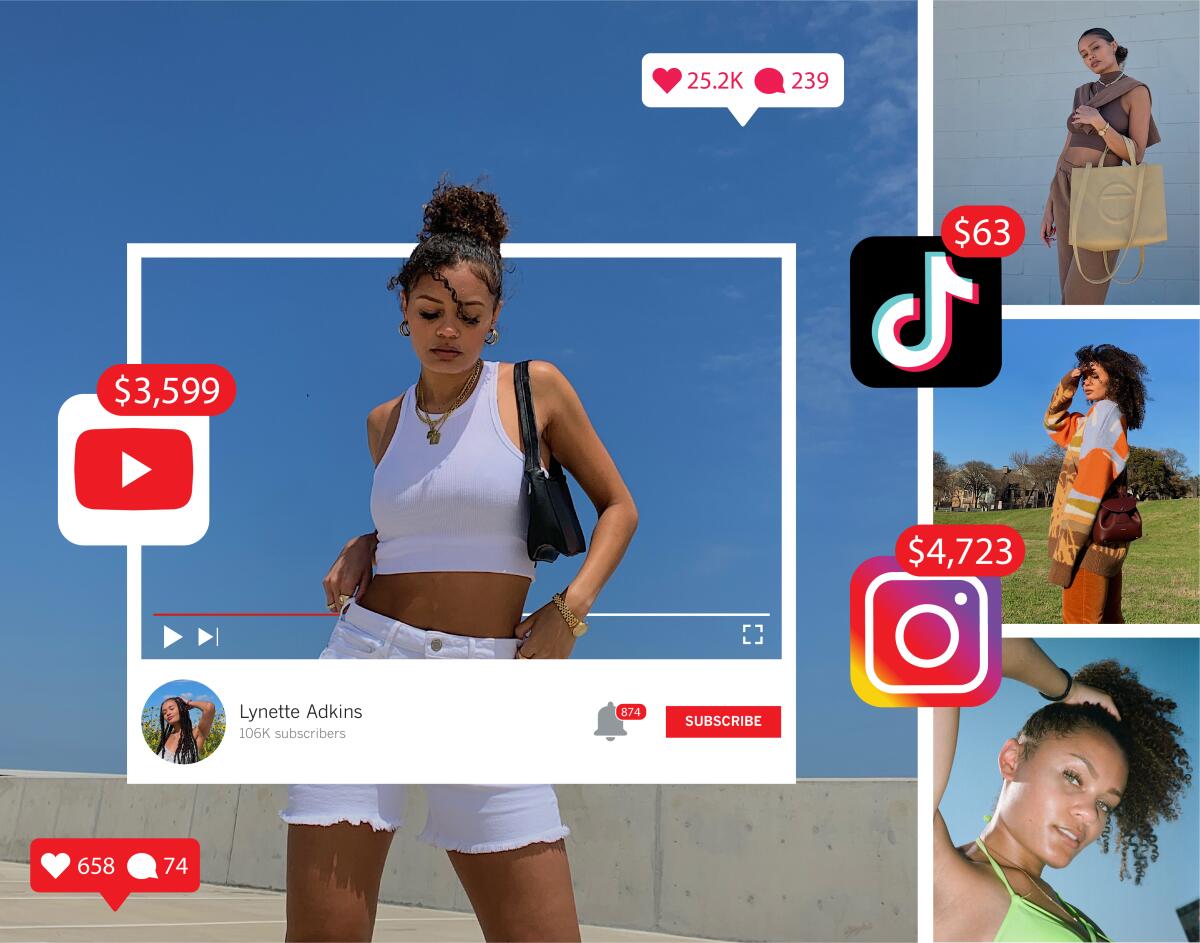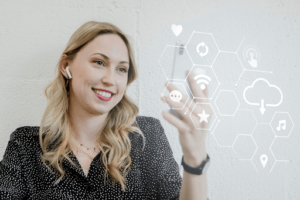How Do Influencers Make Money?
In this age of social media and digital connectivity, influencers have risen to prominence— transforming their online presence into lucrative careers. With their unique voices, captivating content, and engaged audiences, these influencers have transformed their passion and influence into a lucrative business. The significant popularity of social media channels like TikTok, Facebook, Instagram, Snapchat, and YouTube has made all this possible.
– 10 mins

The global influencer marketing market, valued at $15.2 billion in 2022, is growing rapidly to reach 22.2 billion U.S. dollars by 2025. But the question remains—how do influencers make money?
Influencers wield influence over vast audiences, making them invaluable to brands seeking to connect with their target markets. But how do influencers turn likes, shares, and follows into substantial income? The answer lies in their ability to monetize their authenticity, creativity, and expertise.
Let us walk you through the strategies that influencers employ to generate revenue but before we delve deeper, we will try to understand what an influencer is and what are the different types of influencers.
Let us dive in!
What is an influencer?
An influencer is a prominent individual who wields substantial influence over a dedicated online following—typically across various social media platforms. These individuals have garnered trust and credibility within a specific niche or interest area, such as fashion, beauty, fitness, travel, food, or technology. They use platforms, including:
- YouTube
- TikTok
- Snapchat
- Twitter—in addition to other platforms, to share content that resonates with their audience.
Influencers leverage their expertise, authenticity, and relatability to engage and inspire their followers. They can influence their audience’s opinions, behaviors, and purchasing decisions. Influencers often collaborate with brands and businesses to promote products, services, or causes, using their reach and engagement to create authentic marketing campaigns.
The rise of social media has given birth to a new era of digital marketing—where influencer collaborations have become a powerful tool for businesses looking to reach and engage with target demographics. The impact of influencers extends far beyond mere marketing—they have become trusted voices in their respective fields, shaping trends, driving conversations, and serving as influential figures in the digital age.

Ways social media influencers make money
Social media influencers employ various strategies to monetize their online presence, leveraging their follower base and niche expertise.
Here are different ways social media influencers make money, with in-depth explanations for each strategy.
1. Sponsored content
Sponsored content is a primary source of income for influencers. Brands pay influencers to create posts, videos, or stories featuring their products or services. These collaborations are usually disclosed as “sponsored” or “ad.” Compensation varies based on the influencer’s reach and engagement metrics. The influencer’s ability to authentically integrate the brand into their content is crucial for the success of sponsored posts.
The process begins with a partnership—as influencers and brands come together to define the terms of the sponsored content. Negotiations typically revolve around compensation, the scope of work, and the creative direction. Once these terms are agreed upon—influencers set out to craft content that promotes the brand or its products in an authentic and engaging manner. This content can take various forms, including social media posts, videos, blog articles, or live streams.
Transparency is a cornerstone of influencer marketing. Influencers are required to openly disclose that the content is sponsored, ensuring that their audience is aware of the commercial relationship. Sponsored content is then published on the influencer’s platforms—reaching their highly engaged audience. Some influencers may also share the content on the brand’s channels, extending its visibility.
Compensation for influencers can take various forms, such as a flat fee, a percentage of sales, free products, or a combination of these. The success of these partnerships is evaluated based on performance metrics—including engagement, reach, conversions, and return on investment (ROI).
Influencers who can effectively connect with their followers and establish credibility within their niche can earn a substantial income from sponsored content. Earnings vary depending on factors like the influencer’s follower count, niche expertise, and the reach of their online presence—with some influencers commanding high fees for their promotional efforts.
2. Affiliate marketing
Influencers can monetize their online presence through affiliate marketing, a strategy where they promote products or services and earn a commission for each sale generated through their unique affiliate links.
This method involves four key steps.
Step1. Influencers choose relevant affiliate programs or partnerships that align with their niche and resonate with their audience. They seek products or services they genuinely believe in, as authenticity is crucial in building trust with their followers.
Step 2. Influencers create content that showcases the affiliate products or services in an appealing and informative manner. This content can take various forms, such as social media posts, blog articles, videos, or reviews. They integrate their unique affiliate links within this content, which allows the tracking of sales and commissions generated through their promotions.
Step 3. Influencers share this content with their engaged audience. They often use their persuasive skills to explain the benefits of the promoted items, and they emphasize how these products or services can address their followers’ needs or desires.
Step 4. As their audience clicks on the affiliate links and makes purchases, influencers earn a commission for each successful sale.
The commission rates and terms can vary depending on the affiliate program. Some influencers can generate significant income through this method, especially if they have a large and dedicated following, as the more people who make purchases through their links, the higher their earnings.

3. Product promotion and sales
Many influencers collaborate with brands for sponsored content. This involves the influencer creating posts, videos, or stories that feature the brand’s products or services. In return, the influencer receives payment, free products, or both. The compensation varies based on factors like the influencer’s reach, engagement rate, and niche relevance.
Influencers often use affiliate marketing to monetize their recommendations. They include unique affiliate links in their content, and when their followers make a purchase through these links, the influencer earns a commission. This approach can be particularly lucrative if the influencer has a loyal and trusting audience. To enhance their earnings, some influencers negotiate higher commission rates with companies or actively promote products that offer substantial affiliate payouts.
Some influencers establish their own brands or merchandise lines, capitalizing on their personal brand and connection with their audience. This enables them to have direct control over the products they promote and the revenue they generate.
Influencers can also employ e-commerce platforms to sell merchandise related to their niche, such as apparel, cosmetics, or digital products, and leverage their influence to drive sales.

4. Ad Revenue
Influencers generate income through ad revenue primarily on platforms like YouTube, where creators can monetize their content through advertising partnerships. The process begins when an influencer creates and uploads videos to their channel. YouTube then places ads on these videos—which can include skippable ads, non-skippable ads, and banner ads. Influencers earn money when viewers engage with these ads—either by watching them or clicking on them. The revenue is typically shared between the influencer and the platform, with the influencer receiving a portion of the ad earnings.
The specific amount an influencer earns from ad revenue is influenced by several factors—such as the number of views their videos receive, the geographic location of their audience, and the niche or topic of their content. Content that appeals to a broad, global audience tends to attract more advertisers and, therefore, generates higher ad revenue.
The length and quality of the videos also play a role in ad revenue, as longer, high-quality content often results in increased engagement and, consequently, more ad revenue.
Furthermore, by promoting their videos on other social media platforms, influencers can direct more traffic to their YouTube channel—potentially increasing their ad earnings.
In some cases, influencers may also explore sponsorship opportunities within their videos. They can integrate sponsored content seamlessly into their videos, and these partnerships can provide an additional income stream alongside ad revenue.

5. Consulting and coaching
Established influencers can leverage their expertise and online presence to generate income through consulting and coaching services.
Firstly—they can offer one-on-one or group coaching sessions where they share their knowledge and insights with clients seeking guidance in their niche driven field. These sessions are typically conducted over video calls or in-person meetings, allowing influencers to provide personalized advice and strategies. The fees for such services are often determined by the influencer’s reputation and the demand for their expertise.
Additionally, influencers can create and sell online courses or digital resources, such as e-books or webinars, aimed at educating and empowering their audience. These materials can be monetized through platforms like Udemy, Teachable, or even on their own websites.
By offering valuable educational content, influencers can not only generate a steady stream of passive income but also establish themselves as thought leaders and trusted advisors in their field. Their follower base, which is already engaged and interested in their niche, often serves as a ready-made audience eager to invest in these resources.
Consulting can also be a lucrative avenue for influencers. Companies seeking to tap into the influencer’s expertise often approach them for specialized advice, marketing strategies, or collaboration opportunities.
6. Events and public appearances
Influencers with substantial followings may be invited to speak at conferences, host workshops, or make public appearances. They can earn appearance fees, as well as potentially generate additional revenue from ticket sales or merchandise sold at these events.
Influencers can secure paid speaking engagements at conferences, seminars, or workshops related to their niche or expertise. Brands and event organizers often invite influencers to share their insights, experiences, and advice with an engaged audience. These speaking engagements can come with lucrative honorariums or fees.
Influencers can host or participate in meet-and-greet sessions, fan conventions, or exclusive events where their followers pay to interact with them in person. These events often involve personalized interactions, autograph signings, and photo opportunities, and attendees may purchase tickets or access passes to participate.
Lastly, influencers can collaborate with event organizers and brands to co-host or endorse events. This partnership can include promoting the event to their followers, making personal appearances, or even curating content during the event, all of which are compensated opportunities.

7. Exclusive content and memberships
Influencers can generate income by offering exclusive content and memberships to their dedicated followers. They create a sense of exclusivity by providing premium content, such as behind-the-scenes footage, extended videos, or in-depth tutorials, available only to paying subscribers. This exclusive content can be hosted on different platforms or a personal website.
Influencers often offer tiered membership options, allowing followers to choose from various subscription levels. Each tier may provide different perks, such as early access to content, personalized messages, or exclusive merchandise. Subscribers pay a recurring fee, ensuring a steady income stream for the influencer.
Additionally—influencers can interact more closely with their premium members, fostering community and intimacy. This fosters stronger connections and can lead to loyal, long-term support from their most dedicated fans. This way—influencers monetize their content while strengthening their bond with their most passionate supporters.

Ready to make money as an influencer?
Influencers with a large social media following have many opportunities to make money as there are diverse revenue streams available. We have discussed the best ways through which influencers make money.
So what are you waiting for?
Research and analyze the different options—pick the one that best suits your skills and interests, and start building your marketing strategy to make money as an influence.

Surrinder Pandita is a content writer at RankHandy. He has more than 6 years of experience writing for the marketing, HR, and business sectors and aims to provide high-quality content.





